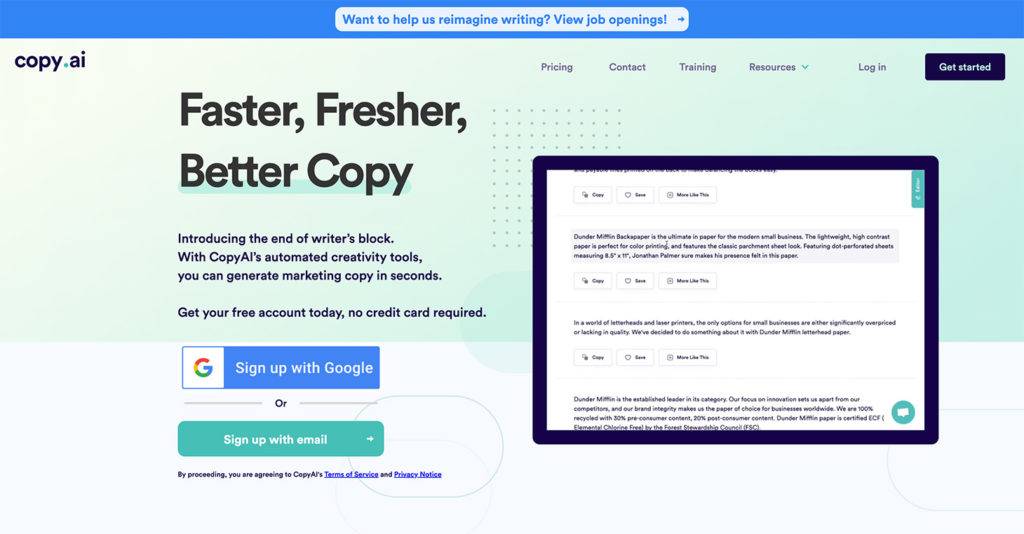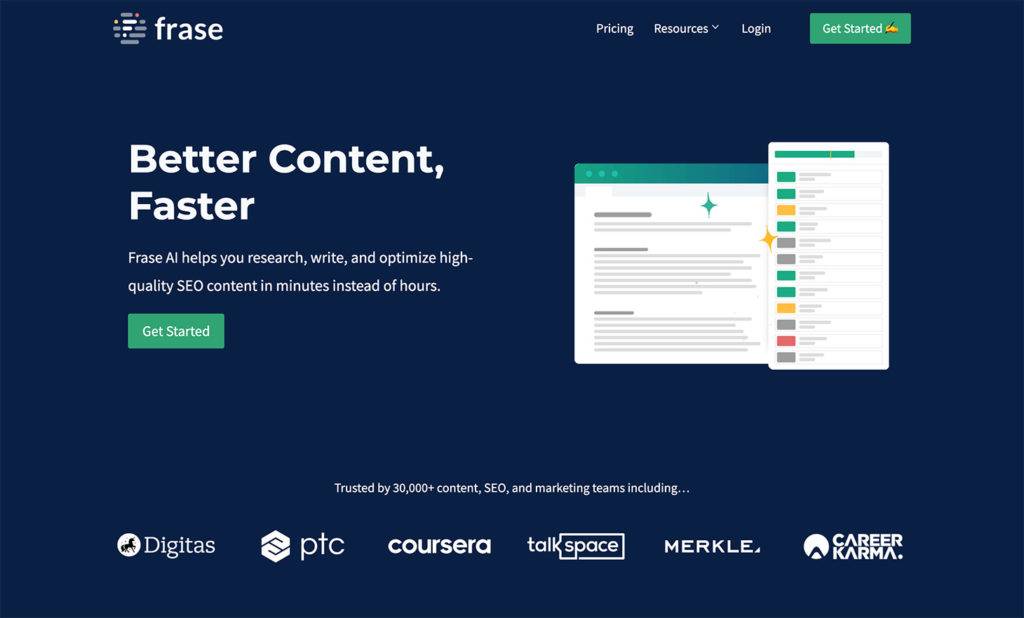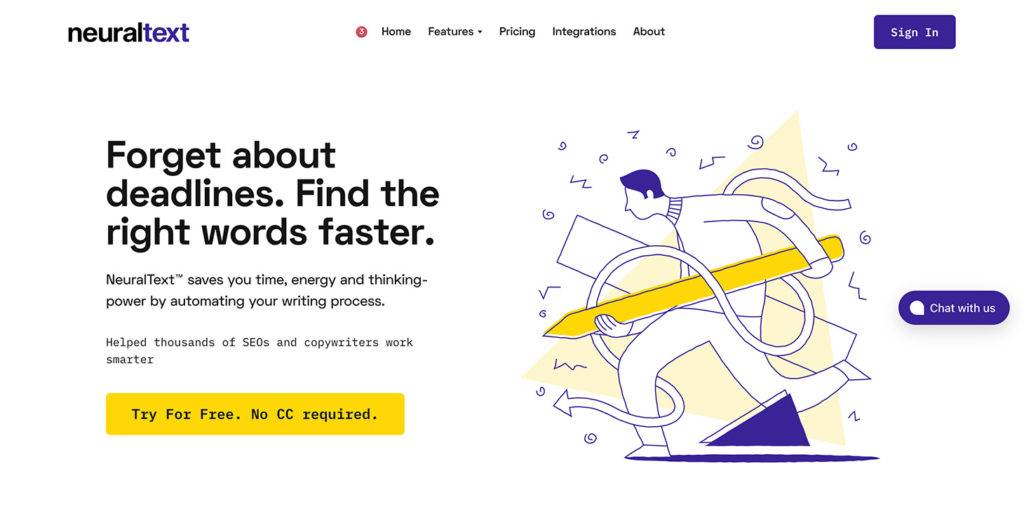Copy.ai
First, I decided to take NLG tool Copy.ai for a test drive. Upon entering your email address, Copy.ai first asks you to answer a short survey which helps the tool customise itself to your requirements and needs. Once on the main dashboard, you can choose from a number of content creation tools, with the most copy-relevant options being:
- Digital ad copy
- Website copy
- Blog tools
- Sales copy
- Writing tools
- Product descriptions

For the purpose of this experiment – and because I feel this is where the site can potentially make some helpful efficiencies – I chose to try the product descriptions tool.
To start generating product description copy, I simply popped in the address of the website I was looking to generate copy for, the product I wanted the copy to discuss and a brief description of that product. I adjusted a few ‘advanced settings’ which consisted of the input and output language and surprisingly, the tone of voice I wanted the copy to be in.
Lo and behold, I hit ‘create’ and was quickly presented with a great list of copy suggestions – all distinct but similar in the fact they all did exactly what I asked the tool to do.
This is what I typed in:
Product name: Strawberry Sundae scented candle
Product description: strawberry scented three-wick candle for use in your home. This scented candle enhances the atmosphere of any room with notes of Strawberry, Waffle Cone, and Vanilla Bean.
And this was the output:
This superb three-wick candle will leave your home smelling delicious with notes of the sweet fragrance of Strawberry, Waffle Cone, and Vanilla Bean. Perfect for using in a smaller room or in a bathroom, simply light and place anywhere where you would like to enhance the atmosphere.
Not bad, right?
What I liked about the tool the most, was the ability to generate copy depending on its use case e.g. a blog introduction, a social post, a product description, a thank you email… even a brand motto. The possibilities are endless.
Copy.ai is also extremely easy to use. Just provide it with a little bit of context, et voila! I couldn’t believe how much copy it generated from such little information.
You’re probably thinking this sounds too good to be true. And, well, you’re mostly right.
While I was very impressed with the tool’s user-friendly experience –and there were some snappy bits of copy that came out of it – there were quite a few shortcomings.
Competitor brand names came up in weird places and almost exact replicas of copy I’d read on the subject elsewhere emerged throughout. Part of me genuinely questioned if using the copy unedited would land me in legal trouble…
If you’re using the tool, you’ll definitely have to sift through some of the outputs to find one that works, and even then it will need a light-touch QA to check the copy is on-brand for your client. That said, it’s great as an initial jumping off point.
Overall, I’d give it a solid 6/10 – mostly for ease of use, and the fact it’s priced extremely reasonably. I’d definitely use it to get me out of that scary blank page scenario as it certainly helped to generate ideas. Could I do that with a little effort and a few Google searches? Probably, if I had the time to spare. Would I trust it to fully generate my client’s product descriptions without QA? No way.
Copy.ai summary
Pros:
- Very easy to use
- Ability to customise input and output language as well as tone of voice
- Ability to generate copy for a variety of purposes
- Able to generate snappy lines
Cons:
- Appears to be directly copying content already published online
- Will use competitor brand names throughout generated copy
- Still needs a copywriter to QA the finished copy
Frase.io
Next up, I was keen to try Frase.io, having heard about it from various industry sources.
Frase.io boldly claims that it’s able to ‘put your entire SEO content workflow on steroids’. It does this by helping to create content briefs, generating ‘quality, high-converting copy at the click of a button’, and providing content optimisation techniques and analytics.

For the purposes of this blog, I was most interested in using it to create content and copy for me.
So how does it do it? Well, essentially, all it takes is a few clicks of the mouse. To get Frase.io to generate content for you, you need to:
- Create a new document
- Enter a longtail keyword such as ‘beach holidays in Greece’
- Select the AI Writer tool, then enter a couple lines of contextual information
- Finally, click ‘write for me’
It sounds straightforward – and up until that point it is – but what I ended up with was something totally different to what I’d hoped for.
The title of the web page I was trying this for was ‘Beach Holidays in Greece’, while the background context of the page I provided it with was: ‘a guide page that describes what to expect on a beach holiday in Greece, with the aim of encouraging people to book a beach holiday there.’
I was also asked to add a few lines of existing copy about the topic, which it would then expand on. This is what I inputted:
‘Exquisite islands, beautiful coastline, ancient stories and delicious food all play their part in the worldwide appeal of Greece. Here the coastline stretches 16,000km, met with the sparkling transparent waters of the Mediterranean.’
I was hoping it would add some further copy about Greek beach holidays specifically…however this is what it came up with:
‘The Greek Islands are so diverse, there is something for everyone. From cosmopolitan Athens, to the sun-drenched beaches of Mykonos; from the snow-capped peaks of Mount Olympus, to the party capital of Santorini. There’s also the historic city of Rhodes with its impressive castle, or the picturesque port town of Corfu.’
Yes, this copy is informative and fairly well-written, but it’s not at all focused on beaches in Greece as I requested, but more so on Greece as a country overall.
When I tried to generate further outputs, it again came up with some semi-decent options, but most were focused on the history of Greece, not the beaches. Additionally, the client I had in mind has a uniquely inspirational and aspirational tone of voice for their copy. There was seemingly no way of specifying this within the tool, or adding any details regarding tone, which meant the copy produced was extremely generic and could likely be found on any travel site.
So, overall, Frase.io gets 5/10. Would it potentially be good for generating ideas or for its optimisation functionality? Probably, yes. But in terms of full-blown content creation, it’s not there yet. The content outputs just aren’t targeted enough. They don’t marry up content and search intent, and don’t take into account a brand’s tone of voice and messaging (as far as I could see).
Frase.io summary
Pros:
- The ability to create briefs, optimise content, and help come up with ideas for how to write about certain topics
- Can use it to write different types of content, i.e. introductions, FAQs, headings and more
- Extremely quick, and relatively easy to use
- Not a bad price point
Cons:
- Could not write based on a specific brand tone of voice
- Didn’t write specifically enough about my chosen subject…therefore missing the point of the brief and the intent of the page
Neuraltext.com
Last but not least, we got to grips with Neuraltext.com. Neuraltext leverages the latest AI technologies, specifically natural language processing and generation, to automate the entire content creation process – from ideation to creation and optimisation. The technologies it uses gain insights from search engines and data from competitors in order to generate copy for a wide range of purposes.

Neuraltext’s uses can be split into three main areas – keyword research, content projects and briefing, and smart copy tools. Again, for the purposes of this blog, I decided to try out some of the features of the smart copy tool. To get started, select ‘smart copy’ from the left-hand side menu, then choose from one of Neuraltext’s 30+ copywriting tools.
These are filtered into categories, like:
- Ideation
- Website tools
- Email tools
- Social media
- Landing page copy
- Ad tools
- Product descriptions
- Writing tools
- Copywriting formulas
I decided to try four of the different copywriting tools that I felt I’d find most useful. These were the blog ideas, blog intro writer, meta descriptions and question generation tools.
For blog ideas, you’re asked to enter a blog name, the audience, and a 2-3 sentence description of your blog or product. With the same luxury travel client in mind, I added ‘Things to see and do in Peru’ as the blog name, ‘people planning to travel to Peru for a luxury holiday’ as the audience, and then a couple of short sentences about some of the key things there are to see and do in Peru. The results weren’t bad for a generic travel blog, giving us titles and focus areas like: ‘11 must-see sites in Lima’ and ‘The Peru trip you’ve been dreaming about’. These types of results would definitely help in terms of idea generation, but when it came to tone of voice, some of the content wasn’t quite right.
Unfortunately, the blog intro tool was worse. All it asks you for is the blog name, so inevitably the results are pretty low quality. I typed in ‘Things to see and do in France’ and was confronted with poorly-written, first-person copy, some of which was even factually incorrect. This was just one of the suggested outputs:
‘The country’s many beautiful landmarks, legendary sites and top cultural attractions such as the Eiffel Tower, the Louvre or the Arc de Triomphe are beautiful enough to make any tourist wonder if they would be allowed to visit them. But France also has some of the most breathtaking natural wonders on Earth. For instance, there is Le Grand Canyon in Arizona, Easter Island in Chile and the Grand Canyon in Utah.’
Moving swiftly on, when it came to meta descriptions, the results I got were a bit of a mixed bag. After inputting the brand name, audience and a brief description of what the brand does, I was served up a variety of different meta descriptions, most of which weren’t really useable. Here’s an example:
‘(Brand name) offers a great variety of luxury holidays in over 50 destinations, covering almost every continent and right to the most exclusive locations. (Brand name) also offers a fast, friendly service that is friendly and efficient.’
In this suggestion, the phrase ‘covering almost every continent’ doesn’t really make sense or read very well, while offering a ‘fast’ service is not one of the brand’s USPs. Additionally, the repetition of ‘friendly’ is unnecessary and makes the copy weak.
Despite this, I did get some results which I could potentially use as a starting point.
Here’s an example of a semi-decent output:
‘(Travel brand)’s boutique luxury holidays offer the ultimate in personalised travel experiences.’
Lastly, I tried out the question generation tool, which could provide helpful questions on a specific topic which could then be used as FAQs. You simply type in a keyword, such as ‘holidays to France’, and the tool will present you with reams of questions informed by queries users are asking in Google. This was by far the most useful tool out of the ones I tried, delivering genuinely helpful questions people might want to know before booking a holiday to France.
These included:
- ‘What is the best time of year to visit France?’
- ‘How can you get the best exchange rate when travelling to France’
- ‘What are some of the most popular tourist destinations in France?’
So, my overall verdict? Another 5/10. Much like the other NLG tools I tried, whilst Neuraltext can give you some good ideas and jumping off points, the outputs provided are questionable to say the least. Some of the copy didn’t make sense or wasn’t factually correct. Most of it wasn’t written in the correct TOV for the brand, and from a grammar and readability perspective…well, it left a lot to be desired.
Neuraltext summary
Pros:
- The ability to create briefs, optimise content, do keyword research, and help come up with ideas for how to write about certain topics
- Has over 30 smart copy tools, allowing you to write different types of content, i.e. introductions, FAQs, meta descriptions and more
- Quick and easy to use
- Good price point
Cons:
- Could not write based on a specific brand tone of voice
- Didn’t write specifically enough about my chosen subject…therefore doesn’t align with a brief or match the intent of the page
- Had to scroll through loads of examples in order to find something that worked
- Best for FAQ generation, ideas and a general starting point
So, are NLG tools useful for copywriting?
Having tried and tested three of the industry’s biggest copy AI tools, I’m still of a similar mindset to the first time I tried NLG tools for copywriting. Yes, these tools can be helpful when used correctly and when given very specific information at the input stage. They can also help make efficiencies and aid with ideation, but – and it’s a big but – they are missing the polish, creativity, and the strategic thinking that a real human copywriter can employ.
If I was lost for ideas or wanted help rewording something, I could see it being beneficial to use NLG copywriting features, but in terms of actually doing the work for me? Not so much.
As mentioned previously though, we must presume the AI technology behind these tools is only going to get better, and when it does, perhaps we can see it as an opportunity for us copywriters to focus on bigger and better things. Having more efficient creation tools would give us more time to focus on things like the overarching strategy of the copy, and how we can adapt our content and make it work even harder. Here at Builtvisible, it’s a challenge we’re more than ready to take on.
